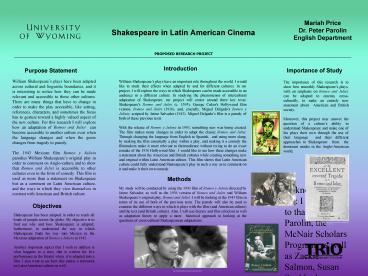Shakespeare in Latin American Cinema - PowerPoint PPT Presentation
1 / 1
Title:
Shakespeare in Latin American Cinema
Description:
Shakespeare in Latin American Cinema Mariah Price Dr. Peter Parolin English Department PROPOSED RESEARCH PROJECT Purpose Statement Introduction Importance of Study – PowerPoint PPT presentation
Number of Views:106
Avg rating:3.0/5.0
Title: Shakespeare in Latin American Cinema
1
Shakespeare in Latin American Cinema
Mariah PriceDr. Peter ParolinEnglish Department
PROPOSED RESEARCH PROJECT
Purpose Statement
Introduction
Importance of Study
William Shakespeares plays have an important
role throughout the world. I would like to study
their effects when adapted by and for different
cultures. In my project, I will explore the ways
in which Shakespeare can be made accessible to an
audience in a different culture. In studying the
phenomenon of intercultural adaptation of
Shakespeare, my project will center around three
key texts Shakespeare's Romeo and Juliet (c.
1595), George Cukor's Hollywood film version,
Romeo and Juliet (1936), and, crucially, Miguel
Delgado's Romeo y Julieta, scripted by Jaime
Salvador (1943). Miguel Delgados film is a
parody of both of these previous texts. With
the release of Romeo y Julieta in 1943, something
new was being created. The film makes many
changes in order to adapt the classic Romeo and
Juliet. Through changing the language from
English to Spanish, and using more slang, by
making the film essentially a play within a play,
and making it a comedy the filmmakers make it
more relevant to theiraudience without trying to
do an exact remake of the 1936 Hollywood film . I
would like to see how these changes make a
statement about the American and British cultures
while creating something new and original within
Latin American culture. This film shows that
Latin American culture could fully understand
Shakespeares play in such a way as to comment on
it and make it their own comedy.
The importance of this research is to show how
smoothly Shakespeares plays, with an emphasis on
Romeo and Juliet, can be adapted to cinema,
cross-culturally, to make an entirely new
statement about American and British
society. Moreover, this project may answer the
question of a cultures ability to understand
Shakespeare and make one of his plays their own
through the use of their language and their
different approaches to Shakespeare from the
dominant modes in the Anglo-American world.
William Shakespeares plays have been adapted
across cultural and linguistic boundaries, and it
is interesting to notice how they can be made
relevant and accessible to these other cultures.
There are many things that have to change in
order to make the play accessible, like setting,
references, characters, and sometimes the focus
has to gesture toward a highly valued aspect of
the new culture. For this research I will explore
how an adaptation of Romeo and Juliet can become
accessible to another culture even when the
language changes and when the genre changes from
tragedy to parody. The 1943 Mexican film Romeo
y Julieta parodies William Shakespeares original
play in order to comment on Anglo-culture and to
show that Romeo and Juliet is accessible to other
cultures even in the form of comedy. This film is
used as more than a statement on Shakespeare but
as a comment on Latin American culture, and the
ways in which they view themselves in contrast
with American and British culture.
www.movieposterdb.com/movie/0037232/Romeo-y-Juliet
a.html
Methods
My study will be conducted by using the 1943 film
of Romeo y Julieta directed by Jaime Salvador, as
well as the 1936 version of Romeo and Juliet and
William Shakespeares original play, Romeo and
Juliet. I will be looking at the 1943 film in
terms of its use of both of the previous texts.
The parody will also be used to examine the
different ways in which it plays with the film
(and American culture) and the text (and British
culture). Also, I will use literary and film
criticism as well as adaptation theory to apply a
more historical approach in looking at the
questions of cross-cultural Shakespearean
adaptations.
Objectives
http//www.classicfilmguide.com/index5267.html
Shakespeare has been adapted in order to reach
all kinds of people across the globe. My
objective is to find out why and how Shakespeare
is adapted furthermore, to understand the way in
which Shakespeare finds his way into Mexico in
the Mexican adaptation of Romeo y Julieta in
1943. Another important aspect that I wish to
address is what happens to a story that is
written for live performance in the theatre when
it is adapted into a film. I also want to see how
this makes a statement on Latin American culture
as well.
http//hudsonshakespeare.org/Shakespeare20Library
/Main20Pages/main_romeoandjuliet.htm
Acknowledgements I would like to thank Dr. Peter
Parolin, the McNair Scholars Program, as well as
Zackie Salmon, Susan Stoddard.
http//articulo.mercadolibre.com.mx/MLM-418092375-
romeo-y-julieta-cantinflas-_JM
http//www.ahoramismo.com.mx/noticia.aspx?id25693































